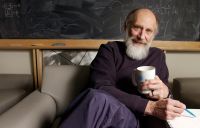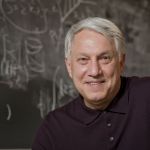Nearly two decades after its proposal, the String Theory Landscape remains divisive among physicists. “In the beginning there were people who hated it. Some hate it even now, and more strongly than before,” Andrei Linde said.
Many view the Landscape as a kind of Faustian bargain: It elegantly explains why the universe appears to be so eerily fine-tuned for life – there are myriad universes and we just happen to live in one that’s tuned for us – but it does so by dashing Einstein’s dream of one day uncovering a “theory of everything” from which the precise values of nature’s laws and constants logically and inevitably arise.
The idea that our universe must have laws suitable for life is called the anthropic principle, and it’s a notion many physicists despise. One U.S. Nobel laureate called it “defeatist” and “dangerous” and said it “smells of religion and intelligent design.”
Even Landscape proponents accept anthropic selection only with a measure of resignation and ambivalence. “Anthropics is distasteful to most string theorists. You’d rather have a nice equation which you can solve to predict the mass of the electron, but that seems very unlikely to me,” Shamit Kachru said. “On the other hand, the Landscape offers in compensation a different kind of elegance: Over vast cosmological scales many solutions are realized; so in that sense, nothing is wasted.”
Renata Kallosh conceded that the anthropic principle “would not be my first choice” for explaining why the universe is the way it is. “In science, the preference will always be given to non-anthropic explanations – unless, however, there is nothing better,” she said.
And there is nothing better at present, according to Leonard Susskind. “It’s not enough to say, ‘I hate the idea.’ You have to say, ‘Here’s a better idea.’ Every month or so somebody will come out with some screwball theory of why the cosmological constant is close to zero, but it won’t last for more than a week,” he said. “A legitimate controversy is when there are two more or less equally good ideas which are in conflict with each other. The simple fact is there is no competition.”
Susskind also thinks that the reports of the death of Einstein’s dream of a unified field theory are greatly exaggerated, and he offers an analogy. “Imagine you live in a world where you only know about one or two different animal species,” he said. “If you were of a scientific bent, you might say, ‘I need to explain why those two species are exactly the way they are.’ Then it’s discovered that there are a lot more different kinds of species, zillions of them. Does that mean that the search for a grand unified theory of life is to be abandoned? No, it means that whatever the fundamental principles are, they shouldn’t be expected to only give rise to a very small number of possibilities. Whatever the ultimate theory for physics is, it should not lead to a conclusion that there’s only one universe. It should lead to the conclusion that there are lots of them.”
After nearly 20 years, particle physicist Savas Dimopoulos is tired of the debate. “Nature doesn’t care about our wishes and hopes,” said Dimopoulos. “Our job is to find out what is true. The important thing is not whether we like these ideas or not, but how to test them. Because in the end, physics has two legs: theory and experiment. To find the truth, you need both.”
Reflecting on 20 years of the landscape

Leonard Susskind
“It’s not enough to say, ‘I hate the idea.’ You have to say, ‘Here’s a better idea.’”

Andrei Linde
“In the beginning there were people who hated it. Some hate it even now, and more strongly than before.”

Renata Kallosh
“In science, the preference will always be given to non-anthropic explanations – unless, however, there is nothing better.”

Eva Silverstein
“We never measure most of what any theory predicts, even empirically well-established ones.”

Savas Dimopoulos
“Nature doesn’t care about our wishes and hopes. Our job is to find out what is true.”

Shamit Kachru
“Landscape offers in compensation a different kind of elegance: Over vast cosmological scales many solutions are realized; so in that sense, nothing is wasted.”
Surveying the Landscape
To that end, Dimopoulos’ group is currently designing ultra-precise “tabletop” experiments to search for millimeter-size extra dimensions that are consistent with string theory. “In string theory, there are six extra dimensions of space, and they can take a tremendous variety of forms,” Dimopoulos said. “This richness tells you that there are many universes, but it also predicts many new particles, including a class of light, weakly interacting massive particles, or WIMPs. If we discover several WIMPs, it will be the first observational evidence that we may have a very complex theory at work.”
The String Theory Landscape will also inform the “Modern Inflationary Cosmology” project, a multi-institution endeavor funded by the Simons Foundation and coordinated by Eva Silverstein. A goal of the project will be to study the primordial seeds of galaxies and other cosmic structures for clues about physics in the early universe. According to inflationary cosmology, the early universe was filled with fields such as the inflaton field and the gravitational field. In some string theory-influenced models of inflation developed by Silverstein and others, fluctuations in these fields were frozen into patterns resembling triangles, rectangles and other shapes, which were preserved as the universe expanded and the fluctuations blossomed into galaxies and other cosmic structures. These patterns, or “non-Gaussianities,” could appear as unusual arrangements of hot spots in the all-sky temperature map produced by the Planck space observatory, as peculiar groupings of galaxies and galaxy clusters in other telescope surveys, or as deviations in the predicted number and type of black holes present in any given region of space.
“Discovering or constraining non-Gaussianities in as systematic a way as possible will improve our knowledge of conditions in the universe roughly 14 billion years ago and help us distinguish between vastly different models of inflation,” Silverstein said, “including some classes that arose from the String Theory Landscape.”
“Inflation once seemed like a wild-eyed fantasy but it now motivates $1 billion experimental proposals and continues to interact with highly theoretical ideas such as the String Theory Landscape. It’s become a part of the cosmological establishment. Whether the String Theory Landscape eventually attains a similar status as part of the standard paradigm, motivating useful experiments, remains to be seen.”
—Shamit Kachru
Professor of Physics
Meanwhile, the science of dark energy continues to evolve as part of astrophysics, independent of the question of whether or not dark energy is Einstein’s cosmological constant. Experiments like the European Space Agency’s upcoming Euclid space mission and the ground-based Large Synoptic Survey Telescope (LSST) being assembled in Chile will measure the acceleration of the universe with unprecedented precision and chart the history of cosmic expansion over the past 10 billion years.
“If we learn through Euclid and LSST that the cosmological constant is only approximately a constant, then we will have to rethink some of the underlying assumptions of the String Theory Landscape,” Kallosh said.
In the end, there may always remain elements of the String Theory Landscape that are difficult or even impossible to test. But this is not unique in science, Silverstein said. “We never measure most of what any theory predicts, even empirically well-established ones,” she said. “It is logically possible to find local support that aspects of string theory are manifested in our observable universe, which would bolster the case that perhaps the more ‘out there’ predictions of the theory – like universes beyond our cosmic horizon – might also be plausible.”
The history of science is littered with crazy-sounding ideas that have panned out, Kachru said. “Inflation once seemed like a wild-eyed fantasy but it now motivates $1 billion experimental proposals and continues to interact with highly theoretical ideas such as the String Theory Landscape. It’s become a part of the cosmological establishment,” he added. “Whether the String Theory Landscape eventually attains a similar status as part of the standard paradigm, motivating useful experiments, remains to be seen.”
Perhaps, Kallosh reflected, physicists are just too impatient. She noted that it took 50 years to confirm the existence of the Higgs boson – the final piece of the Standard Model. “Maybe we just need more time,” she said.